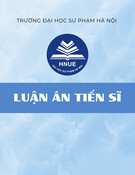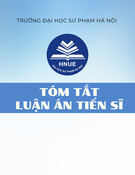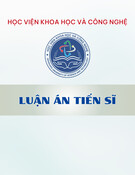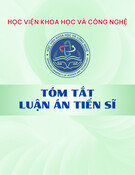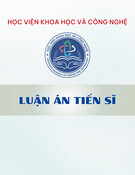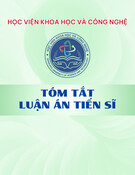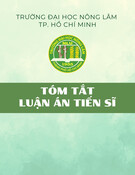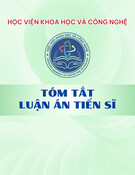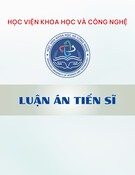VIETNAM ACADEMY OF SCIENCE AND TECHNOLOGY
MINISTRY OF EDUCATION AND TRAINING
GRADUATE UNIVERSITY OF SCIENCE AND TECHNOLOGY
--------------------------------
TRAN THU HUONG
RESEARCH ON CHEMICAL COMPOSITIONS AND BIOLOGICAL ACTIVITIES OF PARAMIGNYA TRIMERA (OILV.) GUILL.) AND MORINDA LONGISSIMA Y. Z. RUAN
Speciality: Chemistry of Natural Products
Code: 9.44.01.17
SUMMARY OF DOCTORAL THESIS IN CHEMISTRY
Ha Noi, 2020
1
The thesis was completed at: Graduate University of Science and
Technology – Vietnam Academy of Science and Technology
Scientific Supervisors 1: Assoc. Prof. Nguyen Manh Cuong
Scientific Supervisors 2: Assoc. Prof. Đo Thi Thao
Reviewer 1: …
Reviewer 2: …
Reviewer 3: ….
This thesis is going to be defended at the council of doctoral thesis
examiners of Graduate University of Science and Technology, Vietnam
Academy of Science and Technology
18 Hoang Quoc Viet, Cau Giay, Hanoi,
at ..., ...., ...2020.
The thesis can be found at:
- Library of Graduate University of Science and Technology
- National Library
2
INTRODUCTION
the south of
- Study on chemical composition of Paramignya trimera
hepatoprotective and anti-HBV
activity of
1. The necessity of the dissertation subject In Vietnam, seven Paramignya species have been identified, distributed mostly the country. in Paramignya trimera (Oliv.) Guill., local name “Than duoc” or “Xao tam phan”, is an endemic plant in South Vietnam. The stems and roots of the plant have been used in folk medicine to treat liver disease, especially cirrhotic ascites. Morinda longissima Y.Z. Ruan. (Rubiaceae) is a small-to- medium tree, contributed in mountainous area in the North provinces of Vietnam. The stems and roots of medicinal plant Morinda longissima has been used by Thai's ethnic people in Son La and Lai Chau provinces for treatment of liver disorders, collitis and oedema. Therefore, the task of studying their chemical composition and biological activities of Morinda longissima and Paramignya trimera species in our country is important and urgent. From that point, the topic “Research on chemical compositions and biological activities of (Paramignya trimea (Oliv.) Guill. (Xao tam phan) and (Morinda longissima Y. Z. Ruan (Nho dong) '' was chosen. 2. The objectives of the thesis and Morinda longissima species. - Evaluation of hepatoprotective and anti-HBV activities of extracts and pure compounds from stems and roots of Xao tam phan (Paramignya trimera (Oliv.) Guill.) and Nho dong (Morinda longissima Y.Z. Ruan). 3. The main contents of the thesis - Evaluation of herbal extracts. - Isolation of compounds from stems and roots of Paramignya trimera (Oliv.) Guill. and Morinda longissima Y.Z. Ruan. - Determination of chemical structures of isolated compounds.
3
- Evaluation of hepatoprotective and anti-HBV activity of isolated compounds. Outline of the thesis: The thesis consists of 139 pages with 45 tables, 21 figures, 4 schemes of isolation and 137 references. The thesis consists of 4 chapters: Introduction (2 pages), Chapter 1: Liturature overview (28 pages); Chapter 2: Materials and Methods (02 pages); Chapter 3: Results (10 pages), Chapter 4: Discussion (83 pages); Conclusion (2 pages); Suggestion (1 page); Publications related to the thesis (1 page); References (15 pages); Appendix (31 pages).
CHAPTER 1: LITERATURE OVERVIEW
isolated
techniques
screening
for
This part reviews the following points: - The chemical composition and biological activities of compounds isolated from Paramignya plants were presented thoroughly. - The chemical compositions and biological activities of compounds from Morinda plants were presented thoroughly. - An overview of biological hepatoprotective and anti-HBV activity was presented in detail.
CHAPTER 2: MATERIALS AND METHODS
2.1.Plant Materials The stems and roots of Paramingya trimera and Morinda longissma were collected in Khanh Hoa province and in Son La province, Vietnam, respectively. The plants were identified by the botanist Dr. Nguyen Quoc Binh, Vietnam National Museum of Nature, VAST. Voucher specimens (C-499 and C-547) are deposited in the herbarium of the Institute of Natural Products Chemistry, VAST, Hanoi, Vietnam. 2.2. Method - Phytochemical techniques - Chromatographic TLC analysis on precoated plates of silica gel 60 F254, separation methods including column chromatography on silica gel, C-18 silica gel, Diaion HP-20, Sephadex LH-20 were used to isolate natural compounds from plant extracts.
4
the extracts and pure natural
- Structures of isolated compounds were identified by physical, chemical and spectroscopic methods including ESI-MS, HR-ESI- MS, IR, UV, 1D và 2D-NMR. - Evaluation of biological activity The biological activities of compounds were evaluated including: -In vitro anti-HBV activity on HepG2.2.15 cell line based on HBsAg expression levels with 50% inhibitory concentration values (IC50). - In vivo hepatoprotective activities against paracetamol-induced hepatotoxicity in BALB/c mice.
two
dimeric monoterpene-linked
CHAPTER 3: EXPERIMENTAL AND RESULTS 3.1. Evaluation of hepatoprotective and anti-HBV activities of herbal extracts 3.2. Isolation of natural compounds from Paramignya trimera From the stems and roots of Paramignya trimera, 10 compounds, including four coumarins: ostruthin (PT-1); ninhvanin (PT-2, new compound); 6-(6-hydroxy-3,7-dimethylocta-2,7- dienyl)-7-hydroxycoumarin (PT-6); ninhvanin B (PT-7, new coumarin compound); glycosides, paratrimerin A (PT-8, new compound); paratrimerin B (PT-9, new compound); a new alcohol, paramitrimerol (PT-5, new compound), a chromene: 6-(2-hydroxyethyl)-2,2-dimethyl- 2H-1-benzopyran (PT-3), an alkaloid: citrusinine-I (PT-4) and a new limonoid, parabacunoic acid (PT-10, new compound) were isolated. - Spectroscopic data of isolated compounds. 3.2. Isolation of natural compounds from Morinda longissima From the stems and roots of Morinda longissima, 22 compounds, including twelve anthranoids: damnacanthal (ML-1); lucidin-ω- methyl ether (ML-2); soranjidiol (ML-3); morindone -5-methyl ether (ML-4); rubiadin (ML-5); rubiadin-3-methyl ether (ML-6); damnacanthol (ML-7); morindone (ML-8); 1-hydroxy-2-methyl-6- methoxy anthraquinone (ML-9); morindone-6-methyl ether (ML- 5
(ML-11);
(ML-12),
(ML-17);
acteoside
lucidin-3-O-β- 10); morindone-6-O-β-gentiobioside two new naphthalene glycosides: primeveroside morinlongoside A (ML-13, new compound); morinlongoside B (ML-14, new compound), two iridoid glycosides: morinlongoside C (ML-15, new compound); geniposidic acid (ML-16), five (3R)-3-O-[β-D-xylopyranosyl-(1→6)-β-D- glycosides: lucopyranosyl]-l-octen-3-ol (ML-18); cistanoside E (ML-19); ethyl-β-D-galatopyranoside (ML-20); isoacteoside (ML-21) and a flavonoid: quercetin (ML-22) were isolated. - Spectroscopic data of isolated compounds. 3.4. Evaluation of hepatoprotective and anti-HBV activities of several pure compounds
CHAPTER 4: DISCUSSION
This chapter presented a discussion of the results of the structural identification and biological evaluation of extract and pure compounds from stems and roots of Morinda longissima and Paramignya trimera 4.1. Evaluation of hepatoprotective and anti-HBV activities of herbal extracts
4.1.1. Evaluation of anti-HBV activities Table 4.1. Effect on viability of HepG2.2.15 cells of extracts
No. species Sample OD % cell viability Code 1 Blank 0,049 2 DMSO 0,805 100 MeOH extract 3 PT 0,920 114,23 P. trimera P. trimera aqueous extracts 4 PR 0,799 99,27 P. trimera PR1 fraction 5 PR1 0,811 100,70 P. trimera PR2 fraction 6 PR2 0,832 103,31 P. trimera PR3 fraction 7 PR3 0,895 111,13 P. trimera PR 4 fraction 8 PR4 0,805 100,02
6
9 P. trimera PR 5 fraction PR5 0,192 23,84 10 M. longissima EtOH extract ML 0,86 102,25 11 M. longissima W aqueous extracts 0,82 107,28
08 samples with cell viability ≥ 80 will be further studied inhibitory activity of secretion of HBV surface antigen
OD (450nm) SE
Conc. 0 µM 50 µM MeOH extract 60 µg/ml aqueous extracts 60 µg/ml PR1 fraction 60 µg/ml PR2 fraction 60 µg/ml PR3 fraction 60 µg/ml PR 4 fraction 60 µg/ml Inhibition ( %) 0 100 42,86 111,88 140,37 115,89 117,19 107,93 103,98 0,190 0,140 1,228 0,016 0,635 0,022 1,351 0,026 1,647 0,066 1,393 0,011 1,406 0,016 1,310 0,035 1,269 0,014
for (HBsAg). Table 4. 1. Inhibitory activity of HBsAg secretion in HepG2.2.15 cells of extracts Sample No. Code Blank 1 2 DMSO Lamivudine 3 4 PT 5 PR 6 PR1 7 PR2 8 PR3 9 PR4 10 ML
EtOH extract 69,37 0,91 0,028 60 µg/ml 85,04 1,051 0,06 11 W aqueous extracts 60 µg/ml
W
Ethanol and aqueous extracts of Morinda longissima showed inhibitory activity of HBsAg secretion in HepG2.2.15 cells. - Table 4. 3. The IC50 values of two active extracts IC50 (μg/ml) Conc, Abs 450 0 µM 19,92±0,18 146,90±30,17 297,76±58,14
0,071 Blank DMSO 1,911 Lamivudine 50 µM 0,905 ML 15 µg/ml 1,856 30 µg/ml 1,754 60 µg/ml 1,567 7,5 µg/ml 1,966 7,5 µg/ml 1,917 15 µg/ml 1,894 30 µg/ml 1,843 60 µg/ml 1,841 Inhibition (%) 0 100 45,30 97,02 91,48 81,31 102,98 100,34 99,09 96,29 90,77 SE 0,007 0,018 0,040 0,001 0,081 0,129 0,000 0,008 0,038 0,028 0,107
7
The ethanol (ML) and aqueous extracts (W) of stems and roots of Morinda longissima showed significant inhibitory anti- HBV activities in vitro. 4.1.2. The hepatoprotective activities Both ethanol and aqueous extracts of Morinda longissima stems and roots exhibited hepatoprotective activities against paracetamol-induced hepatotoxicity in BALB/c mice. Table 4. 2. Effect of methanol extract and aqueous extract on the serum levels of ALT, AST
No. 1 Sample Control 2 Paracetamol 400mg/kg
3 metanol extract10g/kg
4 aqueous extract 10g/kg
5 Silymarin 50mg/kg AST (UI/L) 87,80 ± 1,48 715,75 ± 253,94 p<0,05 so với (1) 116,50 ± 34,65 p<0,05 so với (2) p>0,05 so với (5) 266,00 ± 170,92 p<0,05 so với (2) p<0,05 so với (5) 101,33 ± 23,03 p<0,05 so với (1) p<0,05 so với (2) ALT (UI/L) 28,70 ± 2,59 558,25 ± 296,54 p<0,05 so với (1) 81,25 ± 8,59 p<0,05 so với (2) p>0,05 so với (5) 113,25 ± 27,41 p<0,05 so với (2) p<0,05 so với (5) 46,67 ± 11,47 p<0,05 so với (1) p<0,05 so với (2)
Frigue 4.1. Histopathological changes of liver tissue (A): Control, (B): Paracetamol 400mg/kg, (C): metanol extract 10g/kg, (D) aqueous extract 10g/kg, (E): Silymarin 50mg/kg
4.2. Chemical compositions of Paramignya trimera Compound PT-1 to PT-10 were isolated from the roots of Paramignya trimera. The structures of all isolated compounds (PT-1–10) were elucidated on the basis of spectroscopic data (high resolution (HR)- MS, and one and two dimensional (1/2D)-NMR).
8
PT-3 (6-(2-Hydroxyethyl)-2,2- dimethyl-2H-1-benzopyran), C13H16O2, 203 PT-1 (ostruthin), C19H22O3, 298 PT-2 (ninhvanin) mới, C20H24O4, 328
PT-4 (citrusinine-I), C16H15NO5, 301 PT-5 (paramitrimerol) mới, C14H16O3, 232
PT-6 6-(6-hydroxy-3,7- PT-7 (ninhvanin B) mới, C19H22O4, 314
PT-10 (axit parabacunoic) mới, C32H44O13, 636 dimethylocta-2,7-dienyl)-7- hydroxycoumarin, C19H22O4, 314 PT-9 (paratrimerin B) mới, C40H44O16, 780 PT-8 (paratrimerin A) mới, C45H52O20, 912
Compound PT-8 was obtained as a white amorphous powder 25–25.0o, c = 0.02, MeOH). Its with a negative optical rotation ([α]D molecular formula was determined to be C40H44O16 based on the quasi- molecular ion peak observed at m/z 781.2691 [M+H]+ (calculated for C40H45O16, 781.2702) and m/z 803.2548 [M+Na]+ (calculated for C40H44O16Na, 803.2522) in the positive HR-ESI-MS spectrum. A further fragment ion was identified at m/z 457.1637 ([M–2xC6H10O5+H]+,
9
as
(C10) bridge, determined
calculated for C28H25O6, 457.1651), indicating the presence of two glycosyl moieties in PT-8. The IR spectrum had bands at max 3379, 1646 cm-1, ascribable to hydroxyls and lactone carbonyl groups, respectively. The UV spectrum showed absorbtion maxima, max at 204, 256, 292, and 330 nm, characteristic of a 7-oxygenated coumarinchromophore. The 13C- NMR /DEPT spectra of PT-8 (CD3OD) contained 40 carbon signals (12 x C, 22 x CH, 4 x CH2, 2 x CH3), assignable to two glucosyl moieties, two coumarin nuclei, and a monoterpene ring. Its 1H-NMR spectrum of PT-8, displayed patterns similar to those of ostruthin, with characteristic signals of two pairs of cis-located olefinic protons H-3/H-4 and H-3/H-4(d, J=9.5 Hz, each), as well as two pairs of para-singlet aromatic protons H- 5/H-8, and H-5/H-8 (s, each), indicative of two 6,7-disubstituted coumarin nuclei. The structures of two coumarin nuclei in PT-8 were confirmed based on analysis of HSQC, HMBC, COSY and NOESY spectra. Two anomeric proton signals in PT-8 were observed at δH 4.99 (d, H-1) and δH 4.93 (d, H-1) (each J = 8.0 Hz), together with six pair- wise carbon signals at δC 101.6 (C-1)/102.5 (C-1), 74.8 (C-2)/75.0 (C-2), 78.2 (C-3)/78.3 (C-3), 71.7 (C-4)/71.2 (C-4), 78.4 (C- 5)/78.4 (C-5) and 62.7 (C-6)/62.5 (C-6) (Table 1). This indicated the presence of two glucosyl moieties in the β-configuration. The positions of the β-glucopyranosyl moieties at oxygenated carbons C-7/C- 7 of the two coumarin rings was determined based on the HMBC correlations (Figure 4.12) between the anomeric protons H-1(δH 4.99, d, J = 8.0 Hz) and H-1 (δH 4.93, d, J = 8.0 Hz) to carbons C-7 (δC 158.3) and C-7 (δC 160.0), respectively (Table 4.11, Figure 4.12). The NOESY spectra of PT-8 also confirmed the location of two sugar units based on the cross-peaks from the anomeric protons H-1 and H-1 to the singlet aromatic protons H-8 and H-8, respectively. The structure of the an 1,4-dimethyl-4- monoterpene vinylcyclohexene, was similar to that of some monoterpene–linked biscoumarins isolated from other rutaceous species, such as bisparasin from Citrus paradise and thamnosin from Thamnosma montana. The coupling constant 3J9-10 = 16.5 Hz was indicative of two vicinal protons H-9 (δH 6.41) and H-10 (δH 6.37) in the trans position (Figure 4.12). Furthermore, the monoterpene bridge attached to two glucopyranosyl coumarin units at the non-protonated carbons C-6 (δC 127.7) and C-6(δC
10
131.6) could be directly determined based on the HMBC cross-peaks (3J– correlations) from the coumarinic protons H-5 (δH 7.47) and H-5 (δH 7.39) to the tertiary carbons of the vinylcyclohexene moiety C-9 (δC 121.2) and C-9 (δC 44.3), respectively (Table 4.11, Figure 4.12). Furthermore, two coumarinic protons H-5 and H-5 have NOESY interactions with the vinylic proton H-9 (δH 6.41) and proton H-9 (δH 4.13), respectively. These above spectroscopic evidences confirmed the linkage at C-6/C-9 and C-6/C-9 between the two glucosidic coumarins and the 1,4-dimethyl-4-vinylcyclohexene moiety.
(as
The bis coumarins comprising a cyclohexene ring acting as a bridge between two coumarins are quite common in nature. The cyclohexene ring can be substituted with between 3 to 5 substituents. The most common type is 1,3,4,4-tetrasubstituted cyclohexene (as in in phebalin), whereas 1,3,4,5,5-pentasubstituted cyclohexene toddalosin) is less common. Two coumarin nuclei can link through a 1,4- dimethyl-4-vinylcyclohexene chain at positions C-6/C-8 as in isothamnosin A, at C-8/C-6as in bisparasin, C-8/C-8 as in phebalin, and at C-6/C-6 as in thamnosin and our new compound PT-8. The NOESY spectrum of PT-8 showed a correlation of the methyl signal 11-CH3 (δH 1.31) to proton H-9 (δH 4.13), indicative of a cis-configuration of the 11- CH3 group and proton H-9, as well as a cis-arrangement of two coumarin units on the 1,4-dimethyl-4-vinylcyclohexene ring, similar to the case of bisparasin, a biscoumarin isolated from Citrus plants. Furthermore, the 11-CH3 group has NOESY correlation to the methylene protons H-12 (δH 1.87, m) and H-12 (δH 2.16, m) (Table 4.14), indicating that the cyclohexene ring adopts a half-chair conformation and the 11-CH3 group and proton H-9 are oriented axial- and pseudo-axial on the ring, respectively. Thus, the relative stereochemistry of paratrimerin A (PT-8) was determined to be 9S,11S or 9R,11R.
Figure 4.11. 1H-NMR of compound PT-8
11
Figure 4.12. Selected (COSY, NOESY and HMBC) correlations of compound PT-8
Table 4. 13. 1H and 13C-NMR data of (-)-paratrimerin A (PT-8)
C HMBC 13C1H HMBC 1H13C
1H-NMR ( MeOD, 500 MHz)
NOESY 1H -> 1H - 3, 4 - 6,28, d, 9,5 Hz 7,95, d, 9,5 Hz 4 3 - 7,47, s
- - 2 3 4 4a 5 6 7 8
13C-NMR (MeOD, 125 MHz) 163,28 (s) 114,31 (d) 146,00 (d) 115,19 (s) 126,60 (d) 127,66 (s) 158,35 (s) 103,99 (d)
7,03, s 5 3, 8 4 8, 10 5, 8, 1'' - COSY 1H -> 1H - 4 3 - - - - - 9 1''
- 8a 9 155,22 (s) 121,23 (d) 6,41, d, 16,5 Hz 4, 5, 8 5 - 10 2, 4a 2, 8a, 5 - 4, 7, 8a - 6, 7 4a, 6, 7, 8a - 5, 10 5, 11- CH3
12
140,92 (d) 6,37, d, 16,5 Hz 10 9 9, 11-CH3 11-CH3
9, 11, 11- CH3 - 11 40,22 (s) - 9, 10, 9'
31,95 (t) 1,65-1,88, 2H, m 12 12' 9, 12, 11- CH3 11-CH3
25,82 (q) 1,31, s 12 -
2', 3' - - 6,22, d, 9,5 Hz 7,88, d, 9,5 Hz - 7,39, s
- - 5' 3', 8' 4' 8' 5', 8', 1''' - 11- CH3 2' 3' 4' 4'a 5' 6' 7' 8' 163,49 (s) 114,08 (d) 145,89 (d) 114,40 (s) 130,95 (d) 131,62 (s) 160,03 (s) 103,63 (d) 7,09, s - 4' 3' - - - - - 3' 4' 1'''
- 8'a 9' 155,03 (s) 44,34 (d) 4,13, s -
5,35, s 10, 11, 12' 10, 11, 9', 12' - 2', 4'a 2', 5', 8'a - 4', 7', 8'a - - 4'a, 6', 7', 8'a - 12, 11- CH3, 5' 10' 11' 124,60 (d) 135,60 (s) - 4', 5', 8' 12, 5', 11'- CH3 11'-CH3 12, 11'-CH3 12' 28,56 (t) 12 8 12, 11'-CH3
23,66 (q) 2,29, m 2,16, m 1,85, s - -
11'- CH3 1'' 2'' 3'' 4'' 5'' 6'' 101,62 (d) 74,77 (d) 78,19 (d) 71,71 (d) 78,42 (d) 62,72 (t) 4'' 7 2'' 1'' 8
1''' 2''' 4,99, d, 8 Hz 3,35-3,4, m 3,42 -3,53, m 3,23, 1H, t, 9 Hz 3,42 -3,53, m 3,85, dd, 12, 2 Hz 3,35-3,39, m 4,93, d, 7,5 Hz 3,58, dd, 8,0, 8,0 Hz 7' 2''' 1''' 8'
3''' 4''' 5''' 6''' 102,49 (d) 75,01 (d) 74,77 (d) 78,34 (d) 71,21 (d) 78,38 (d) 62,48 (t) 3,42 -3,53, m 3,33-3,39, m 3,42 -3,53, m 3,88, dd, 12, 2 Hz 3,70, dd, 12, 6,5 Hz
4.3. Chemical compositions of Morinda longissima Compound ML-1 to ML-22 were isolated from the stems and roots of Morinda longissima. The structures of all isolated compounds (ML-1 - ML-22) were elucidated on the basis of spectroscopic data (high resolution (HR)-MS, one and two dimensional (1/2D)-NMR).
13
Damnacanthal (ML-1) C16H10O5, 282 Sorandidiol (ML-3) C15H10O4, 254 Lucidin-ω-methyl ether (ML-2) C16H12O5, 284
Rubiadin (ML-5) C15H10O4, 254 Rubiadin-3-methyl ether(ML- 6), C16H12O4,268 Morindone-5-methyl ether (ML- 4), C16H12O5, 284
Morindone (ML-8) C15H10O5, 270 Damnacanthol (ML-7) C16H12O5, 284 1-hydroxy-2-methyl-6- methoxy anthraquinone (ML-9) C16H12O4, 268
Morindone-6-methyl ether (ML- 10) C16H12O5, 284 Morindone-6-O-β- Gentiobioside(ML-11) C27H30O15, 594 Lucidin-3-O-β- primeveroside (ML-12) C26H28O14, 564,5
morinlongoside A (ML- 13) C29H38O15, 626 morinlongoside B (ML- 14) C27H36O13, 568 morinlongoside C (ML- 15) C22H32O15, 536
14
Cistanoside-E (ML-18) C21H32O12, 476,47 Geniposidic acid (ML- 16) C16H22O10, 374 3-O-[β-D-Xylopyranosyl-(1-6)-β- D-glucopyranosyl] (3R)-l-octen-3-ol (ML-17) C19H33O10, 421
Isoacteoside (ML-20) C29H36O15, 624 Ethyl-β-D- galatopyranoside (ML- 19) C8H16O6, 208,09
Acteoside (ML-21) C29H36O15, 624 Quercetin (ML-22) C15H10O7, 302
4.4. Evaluation of hepatoprotective and anti-HBV activities of of several compounds 4.4.1. Evaluation of anti-HBV activities
Viability of HepG2.2.15 cell was tested using MTS
assay after 48 hr incubation.
Table 4.4. Effect on viability of HepG2.2.15 cells of pure
compounds
No. Sample Conc. OD % cell viability 1 Blank 0,049 2 DMSO - D6 0,805 100
15
3 ostruthin (PT-1) 10 µM 0,165 20,55 4 ninhvanin (PT-2) 10 µM 0,625 77,60 5 10 µM 0,905 112,37 6 6-(2-Hydroxyethyl)-2,2-dimethyl- 2H-1-benzopyran (PT-3) paratrimerin A (PT-8) 10 µM 0,900 111,81 7 paratrimerin B (PT-9) 10 µM 0,713 88,59 8 10 µM parabacunoidc acid (PT-10) 0,53 65,81 9 morindone (ML-8) 10 µM 1,011 125,60 10 damnacanthal (ML-1) 10 µM 0,800 99,39 11 rubiadin (ML-5) 10 µM 1,014 125,97
05 compounds with cell viability ≥ 80 will be further studied for inhibitory activity of secretion of HBV surface antigen (HBsAg). Table 4. 5. Inhibitory activity of HBsAg secretion in HepG2.2.15 cells of pure compounds No. Sample
Conc. OD (450nm) SE
HBsAg Inhibition (%) 0,190 0,140 1,228 0,016 0,635 0,022 0 100 42,86 0 µM 50 µM 1 2 3 4 20 µM 1,276 0,044 104,61
Blank DMSO Lamivudine 6-(2-Hydroxyethyl)-2,2- dimethyl-2H-1-benzopyran (PT-3) paratrimerin A (PT-8) 5
6 7 8 1,300 0,061 0,992 0,067 1,077 0,094 1,058 0,077 20 µM 20 µM 20 µM 20 µM 106,92 77,28 85,42 83,64 morindone (ML-8) damnacanthal (ML-1) rubiadin (ML-5) Morindone (ML-8), rubiadin (ML-5) and damnacanthal (ML-1)
showed significant inhibitory activity of HBsAg secretion.
Table 4. 6. The IC50 values of anthraquinone ML-8, ML-1 and ML-5
Conc. Abs 450 SE
Blank DMSO Lamivudine 0 µM 50 µM 0,071 1,911 0,905 0,007 0,018 0,040 HBsAg Inhibition (%) 0 100 45,30 IC50 (µM) 19,92±0,18
16
2,5 µM 1,829 0,026 95,53 morindone (ML-8)
5 µM 10 µM 20 µM 2,5 µM 1,577 1,465 1,315 1,813 0,015 0,056 0,089 0,009 81,85 75,74 67,61 94,66 32,06±3,21 5 µM 1,711 0,067 89,11 32,54±3,05
10 µM 20 µM 2,5 µM 1,471 1,275 1,858 0,107 0,003 0,081 76,06 65,41 97,13 5 µM 1,809 0,019 94,44 45,82±10,79
damnacanthal (ML-1) rubiadin (ML- 5) 10 µM 20 µM 1,657 1,409 0,042 0,053 86,20 72,72
.4.4. The hepatoprotective activities of isolated
the 50 mg/kg/day reduced
Morindone (ML-8), rubiadin (ML-5) and damnacanthal (ML-1) exbihited anti-HBV in vitro effect on HepG2.2.15 cell line based on HBsAg expression levels. conpound Ninhvanin (PT-2, new compound), at the 50 mg/kg/day reduced the serum ALT concentration as well as partly limited the liver injury induced by paracetamol (400 mg/kg). Ostruthin (PT-1) the serum ALT and AST at concentrations and limited the liver injury induced by paracetamol. Ostruthin exhibited the strong hepatoprotective activities equal to those of silymarin at the same dose of 50 mg/kg/day. Table 4. 7. Effect of ostruthin and ninhvanin on the serum levels of ALT, AST Lô
Sample Control 1 paracetamol 400mg/kg 2
ostruthin 50 mg/kg 3
ALT (UI/L) 29,20 ± 2,59 495,67 ± 61,50 p< so với (1) 62,00 ± 23,30 p< so với (1) p<0,01 so với(2) p> so với (5) AST (UI/L) 84,20 ± 3,90 324,00 ± 50,54 p< so với (1) 97,00 ± 15,72 p> so với (1) p< so với (2) p>so với (5)
17
ninhvanin 50 mg/kg 4 283,00 ± 11,13 p>so với (2) p< so với (5)
silymarin 50 mg/kg 5 90,32 ± 19,06
p> so với (1)
pFigure 4. 1 Histopathological changes of liver tissue (A): Control
group, (B): Paracetamol 400mg/kg, (C): Silymarin 50mg/kg, (D)
ostruthin 50 mg/kg P, (E): ninhvanin 50 mg/kg
CONCLUSION
Two medicinal species, Paramignya trimera (Xao tam
longissima (Nho dong) were studied
liver histopathological
phan) and Morinda
systematically on chemical composition and biological activities.
Biological activities of two plants extracts:
Both ethanol and water extracts of Morinda longissima
stems and roots exhibited in vitro anti-HBV activity through
inhibition of HBsAg secretion of HepG2.2.15 cells with IC50 values
of 146.90 ± 30.71 μg/ml and 297.76 ± 58.14 μg/ml, respectively.
The aqueous extracts of Paramignya trimera roots at the
oral dose of 10 g/kg/day weight has reduced serum AST and ALT
injury by
concentrations, decreased
paracetamol (single dose 400 mg/kg, oral). The methanol extract of
Paramignya trimera roots exhibited potential hepatoprotective
effect which was similar to those of the positive control (silymarin
at the dose of 50 mg/kg/day).
Chemical composition:
From the stems and roots of Paramignya trimera, 10
compounds, including four coumarins: ostruthin (PT-1); ninhvanin
18
(ML-17);
acteoside
the 50 mg/kg/day reduced
(PT-2, new
compound); 6-(6-hydroxy-3,7-dimethylocta-2,7-
dienyl)-7-hydroxycoumarin (PT-6); ninhvanin B (PT-7, new
compound); two dimeric monoterpene-linked coumarin glycosides,
paratrimerin A (PT-8, new compound); paratrimerin B (PT-9, new
compound); a new alcohol, paramitrimerol (PT-5, new compound),
a chromene: 6-(2-hydroxyethyl)-2,2-dimethyl-2H-1-benzopyran
(PT-3), an alkaloid: citrusinine-I (PT-4) and a new limonoid,
parabacunoic acid (PT-10, new compound) were isolated.
From the stems and roots of Morinda longissima, 22
compounds, including twelve anthranoids: damnacanthal (ML-1);
lucidin-ω-methyl ether (ML-2); soranjidiol (ML-3); morindone -5-
methyl ether (ML-4); rubiadin (ML-5); rubiadin-3-methyl ether
(ML-6); damnacanthol (ML-7); morindone (ML-8); 1-hydroxy-2-
methyl-6-methoxy anthraquinone (ML-9); morindone-6-methyl
ether (ML-10); morindon-6-O-β-gentiobioside (ML-11); lucidin-3-
O-β-primeveroside (ML-12), two new naphthalene glycosides:
morinlongoside A (ML-13, new compound); morinlongoside B
(ML-14, new compound), two iridoid glycosides: morinlongoside
C (ML-15, new compound); geniposidic acid (ML-16), five
(3R)-3-O-[β-D-xylopyranosyl-(1→6)-β-D-
glycosides:
lucopyranosyl]-l-octen-3-ol
(ML-18);
cistanoside E (ML-19); ethyl-β-D-galatopyranoside (ML-20);
isoacteoside (ML-21) and a flavonoid: quercetin (ML-22) were
isolated.
Biological effects of several pure compounds
Three anthranoids, morindone (ML-8), damnacanthal (ML-
1), rubiadin (ML-5) exhibited an inhibitory activity on HBsAg
secretion of HepG2.2.15 cells with IC50 values of 32,06 ± 3,21 μM,
32,54 ± 3,05 μM and 45,82 ± 10,79 μM, respectively.
Ninhvanin (PT-2, new compound), at the 50 mg/kg/day
reduced the serum ALT concentration as well as partly limited the
liver injury induced by paracetamol (400 mg/kg). Ostruthin (PT-1)
at
the serum ALT and AST
concentrations and limited the liver injury induced by paracetamol.
19
Ostruthin exhibited the strong hepatoprotective activities equal to
those of silymarin at the same dose of 50 mg/kg/day.
RECOMMENDATIONS
trimera and Morinda
The study results of chemical composition and biological
longissima
activity of Paramignya
demonstrate that:
- Further study on ostruthin (PT-1) is necessary to establish the
efficacy, safety, and exact mechanism of action as a moral
alternative in the treatment of liver disorders.
- Three anthranoids, morindone (ML-8), damnacanthal (ML-1) and
rubiadin (ML-5) are potential compounds for research and
development of drugs to treat HBV. Therefore, further anti-HBV
evaluation of these compounds need to be studied at in vivo level.
paramitrimerol
paratrimerin B
NEW CONTRIBUTIONS OF THE THESIS
- This is the first study on the chemical constituents and biological
activities of Paramignya trimera and Morinda longissima in the world.
- From the the stems and roots of Paramignya trimera, 06 new
compounds (ninhvanin (PT-2), ninhvanin B (PT-7), paratrimerin A
(PT-8),
(PT-5),
(PT-9),
parabacunoic acid (PT-10) were isolated and elucidated the
chemical structure. Especially, paratrimerin A, and paratrimerin B
are the first monoterpen-linked biscourmarin glycosides isolated
from nature.
- Two new naphthalene glycosides, morinlongoside A (ML-13),
morinlongoside B (ML-14), an iridoid glycosides, morinlongoside
C (ML-15) were isolated from the stems and roots of Morinda
longissima.
- The metanol extract and ostruthin from stems and roots
of Paramignya trimera exhibited the strong hepatoprotective
activities against paracetamol-induced hepatotoxicity in BALB/c
mice.
- This is the first time, the ethanol and aqueous extracts and
morindone (ML-8), damnacanthal (ML-1), rubiadin (ML-5) from
20
stems and roots of Morinda longissima were found to have anti-
HBV activity in vitro through inhibition of HBsAg secretion of
HepG2.2.15 cells.
PUBLICATIONS RELATED TO THE THESIS
1. Patent: Isolation and purification process of coumarin ostruthin
possessing hepatoprotective activity from stems and roots Paramignya
trimera, According to the decision No. 29620 / QD -SHTT, May 21,
2015.
2. Patent: Isolation and purification process of biscoumarin monoterpen
glycoside from Paramignya trimera, No. 1803, According to Decision
No. 53659 / QD-SHTT, 30 / July 2018.
1. Nguyen Manh Cuong, Tran Thu Huong, Ninh The Son, To Dao
Cuong, Doan Thi Van, Pham Ngoc Khanh, Vu Thi Ha, Nguyen Cong
Thuy Tram, Pham Quốc Long, Young Ho Kim, Morinlongosides A-C,
Two New Naphthalene Glycosides and a New Iridoid Glycoside from the
Roots of Morinda longissima, Chem, Pharm, Bull, 64(8), 1230-4, 2016.
2. Tran Thu Huong, Nguyen Manh Cuong, Pham Ngoc Khanh, Nguyen
Van Tai, Vu Thi Ha, Ninh The Son, Bui Huu Tai, Young Ho Kim,
Paratrimerin A – a novel rare dimeric monoterpene-linked coumarin
glucoside from the roots of Paramignya trimera, Chem.Pharm.Bull. ,
2015, 63(11), 945-949.
3. Tran Thu Huong, Vu Thi Ha, Ninh The Son, To Dao Cuong, Tran
Quoc Toan, Nguyen Thi Thu Tram, Sun Hee Woo, Young Ho Kim,
Nguyen Manh Cuong, New consituents from the roots and stems of
Paramignya trimera, Natural product communications, 2019,1-9.
4. Nguyen Manh Cuong, Tran Thu Huong, Pham Ngoc Khanh, Ninh The
Son, Nguyen Thi Cuc, Đo Thi Thao, Hepatoprotective activites of
Paramignya trimera roots in mice model with liver injury induce by
paracetamol, Journal of Science and Technology, 2016, 51(1),37-45.
5. Nguyen Manh Cuong, Pham Ngoc Khanh, Nguyen Van Tai, Đoan Thi
Van, Vu Thi Ha, Ngo Thi Phuong, Le Minh Ha, Pham Quoc Long, Tran
Thu Huong, Anthranquinone isolated from stems and roots of Morinda
longissima Y. Z. Ruan, collected in Viet Nam, Journal of Viet Nam
Science and Technology, 2015, 2(8), 60-64.
6. Nguyen Manh Cuong, Pham Quoc Long, Tran Thu Huong, Ninh The
Son, Đoan Thi Van, Pham Ngoc Khanh, To Đao Cuong, Vu Thi Ha,
21
Nguyen Cong Thuy Tram, Phenylethanoid glucoside and anthraquinone
compounds from Morinda longissima Y.Z.Ruan roots, J. Chem., 2016,
54(2e) 133-38.
22

